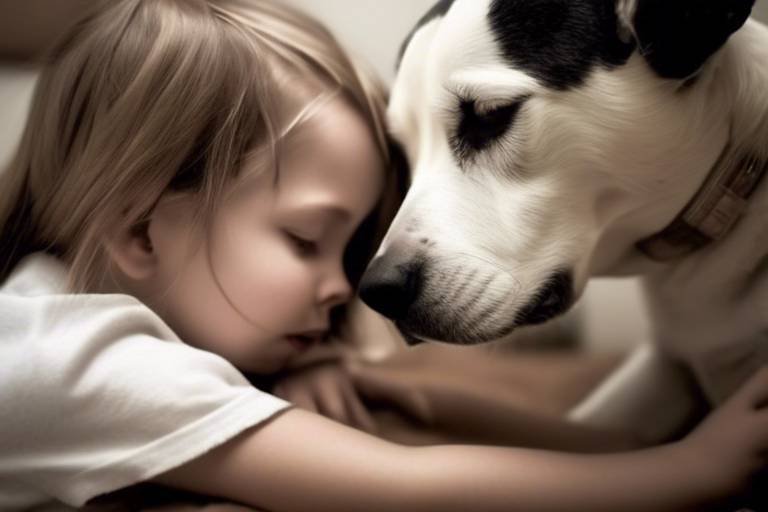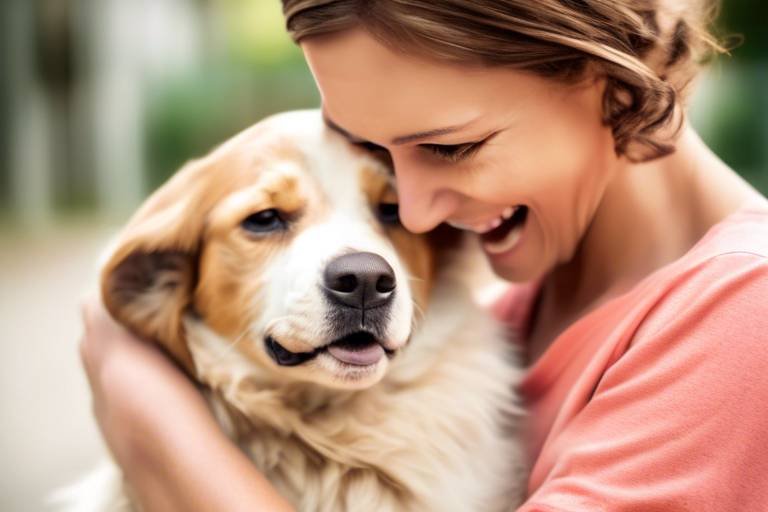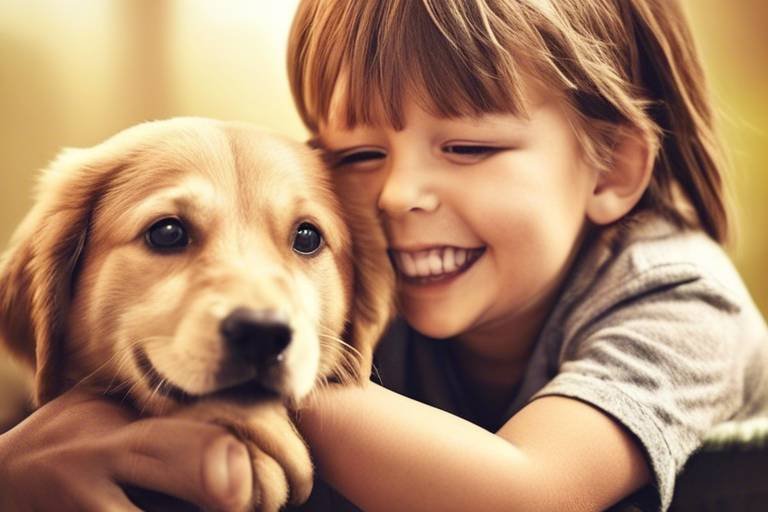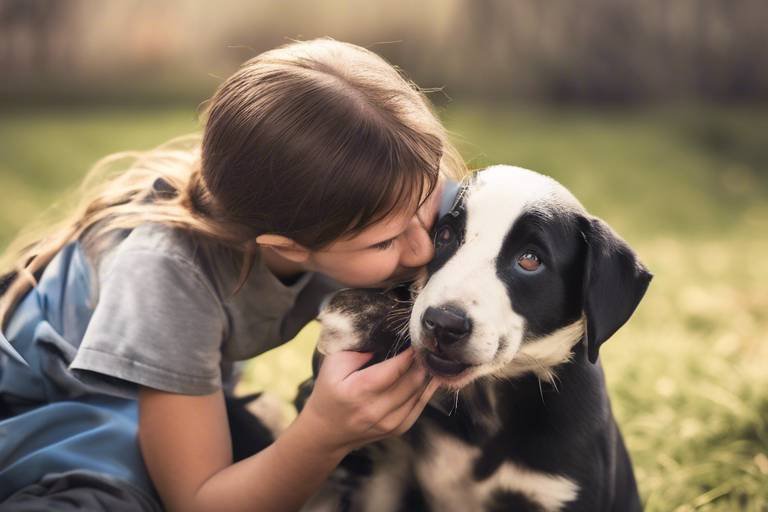The Importance of Training for Adopted Pets
Training is crucial for adopted pets to ensure their well-being and integration into a new home. When you bring a new pet into your life, it’s not just about providing food, shelter, and love; it’s about helping them adjust to their new surroundings and teaching them how to coexist harmoniously with their new family. Just like a new kid in school needs guidance to fit in, adopted pets require training to navigate their new environment. This article explores various aspects of training, its benefits, and effective methods to enhance the bond between pets and their owners.
Adopted pets often come with unique backgrounds and experiences. Some may have been abandoned, while others could have faced neglect or trauma. Recognizing their specific needs is essential for effective training and creating a nurturing environment that fosters trust and security. Imagine stepping into a new place where everything feels foreign; that’s what your new pet might be experiencing. By understanding their past, you can tailor your approach to training, making it a more compassionate and effective process.
Training provides numerous benefits, including improved behavior, enhanced communication, and a stronger bond between pet and owner. Think of training as the glue that holds your relationship together. When both you and your pet understand each other better, it motivates you to commit to the training process. Here are some key benefits:
- Improved Behavior: Training helps correct unwanted behaviors, making your home a more peaceful place.
- Enhanced Communication: Training establishes a clear way for you and your pet to communicate, reducing misunderstandings.
- Stronger Bond: Working together during training sessions builds trust and affection.
Training helps address behavioral issues commonly seen in adopted pets, such as anxiety or aggression. Just like a well-tuned instrument plays beautiful music, a well-trained pet can create harmony in your household. By employing consistent techniques, owners can foster a more harmonious living environment for both the pet and family. Consistency is vital; it’s like teaching a child the same lesson repeatedly until they grasp it. When your pet learns what’s expected of them, they feel more secure and confident.
Adopted pets may experience anxiety due to changes in their environment. Imagine being uprooted from your home and placed in a completely new setting; it can be overwhelming! Training can help alleviate this stress, providing them with structure and predictability, which aids in their adjustment. Simple commands can give your pet a sense of purpose and routine, helping them feel more at ease in their new home.
Proper training can prevent aggressive behaviors that may arise from fear or uncertainty. Teaching pets appropriate responses to various situations promotes safety and comfort within the household. Consider this: when a child learns how to handle conflicts peacefully, they’re less likely to react violently. Similarly, training your pet to respond to stressors calmly can drastically reduce the chances of aggressive outbursts.
Training sessions serve as an opportunity for owners to connect with their pets. Engaging in positive reinforcement techniques fosters trust and strengthens the emotional bond between them. Think of it as a dance; the more you practice together, the more in sync you become. Each successful training session reinforces your relationship, turning it into a partnership based on mutual respect and understanding.
There are various training methods available for adopted pets. Understanding which techniques work best can lead to more successful outcomes and a more enjoyable training experience for both pet and owner. Here are some effective techniques to consider:
Positive reinforcement is one of the most effective training methods. Rewarding desired behaviors encourages pets to repeat those actions, creating a positive learning environment that benefits both parties. Imagine if every time you did something right, you received a compliment; you’d be more likely to keep doing it! This method not only teaches your pet what you want them to do but also makes them feel good about it.
Consistency is key in any training regimen. Establishing clear rules and routines helps pets understand expectations, making the training process smoother and more effective for everyone involved. Just like in a game, everyone needs to know the rules to play well. When your pet knows what to expect, they’re more likely to thrive in their new environment.
1. How long does it take to train an adopted pet?
Training duration varies based on the pet's background and the owner's commitment. Some pets may learn quickly, while others may take more time.
2. Can I train my pet myself?
Absolutely! With patience and consistency, many owners can successfully train their pets. However, consider seeking professional help for more challenging behaviors.
3. What if my adopted pet has anxiety issues?
Consult with a veterinarian or a professional trainer to develop a tailored approach that addresses your pet's specific anxiety triggers.

Understanding the Needs of Adopted Pets
When you bring an adopted pet into your home, you're not just gaining a furry friend; you're also taking on the responsibility of understanding their unique needs. Each adopted pet comes with its own history, which may include past traumas, socialization challenges, or even health issues. Recognizing these factors is crucial for creating an environment that promotes trust and security. Just like humans, pets have their own personalities, quirks, and fears, which can significantly influence their behavior.
One of the first steps in understanding your new companion is to consider their background. For instance, a dog that has been rescued from an abusive situation may display signs of fear or anxiety. On the other hand, a cat that has lived in a shelter for an extended period might be shy or hesitant to explore its new surroundings. By being aware of these potential issues, you can tailor your training approach to meet your pet’s specific needs.
Creating a nurturing environment involves several key elements:
- Routine: Establishing a consistent daily routine can help your adopted pet feel more secure. Regular feeding times, walks, and play sessions create predictability, which is essential for their adjustment.
- Safe Space: Providing a designated area where your pet can retreat when feeling overwhelmed is vital. This could be a quiet room or a cozy bed in a corner of the living room.
- Socialization: Gradually introducing your pet to new experiences, people, and other animals can help build their confidence. Remember, it's essential to go at their pace to avoid overwhelming them.
Moreover, understanding body language is crucial. Pets communicate through their actions, and being able to read these signals can help you respond appropriately. For example, a dog that tucks its tail or a cat that flattens its ears may be feeling scared or threatened. By observing these behaviors, you can adjust your interactions and training methods to better support your pet's emotional needs.
In conclusion, understanding the needs of adopted pets is a multi-faceted process that requires patience, empathy, and a willingness to learn. By acknowledging their backgrounds and providing a supportive environment, you set the stage for a successful bond with your new furry family member. Remember, every small step you take towards understanding your pet can lead to a happier, healthier, and more harmonious household.

Benefits of Training for Adopted Pets
Training is not just a luxury for adopted pets; it is a necessity that can dramatically transform their lives and the lives of their new families. When you bring an adopted pet into your home, you are also bringing in a unique set of experiences, emotions, and sometimes, challenges. Training provides a framework that helps both the pet and the owner navigate this new relationship. It is the bridge that connects understanding with action, allowing for a smoother transition into a loving home.
One of the most significant benefits of training is the improvement in behavior. Many adopted pets come with behavioral quirks that can stem from previous traumas or lack of socialization. Training helps address these issues, leading to a more harmonious living environment. For instance, a dog that barks excessively out of fear can learn to feel secure and calm through consistent training techniques. This not only enhances the pet's quality of life but also contributes to the overall peace of the household.
Additionally, training enhances communication between pets and their owners. Just like humans, pets have their own ways of expressing needs and emotions. By establishing a training routine, you create a language of sorts that both you and your pet can understand. This mutual understanding fosters a stronger bond, making it easier to interpret your pet's needs and respond appropriately. Consider it like learning a new dialect; the more you practice, the more fluent you become!
Moreover, the bond formed during training sessions is invaluable. Engaging in positive reinforcement techniques—like treats, praise, or play—encourages pets to associate training with fun and reward. This not only makes training enjoyable but also strengthens the emotional connection between you and your pet. Imagine the joy of your dog wagging its tail, excited to see you because it knows a fun training session is on the horizon!
In summary, the benefits of training for adopted pets are multifaceted. It leads to:
- Behavioral Improvement: Reduces issues stemming from anxiety or past trauma.
- Enhanced Communication: Establishes a mutual understanding between pet and owner.
- Stronger Emotional Bonds: Creates a loving and trusting relationship.
Investing time and effort into training is an investment in your pet's happiness and your own peace of mind. It paves the way for a fulfilling life together, marked by understanding, trust, and joy. So, if you’ve recently adopted a furry friend, consider training not as a chore, but as an exciting journey you can embark on together!
Q1: How long does it take to train an adopted pet?
A: The duration of training can vary widely depending on the pet's age, breed, and previous experiences. Generally, with consistent practice, you can see improvements in a few weeks.
Q2: What if my adopted pet has behavioral issues?
A: Many adopted pets come with behavioral challenges, but with patience and the right training techniques, these issues can often be resolved. Consider consulting a professional trainer if needed.
Q3: Can I train my pet at home?
A: Absolutely! Many effective training techniques can be practiced at home. Just ensure you maintain consistency and use positive reinforcement.
Behavioral Improvement Through Training
When it comes to our furry friends, training is not just about teaching them tricks or commands; it’s about transforming their behavior for a happier life together. Adopted pets often come with their own set of challenges, shaped by their past experiences and environments. This is where effective training plays a pivotal role in behavioral improvement. By utilizing consistent training techniques, we can address and modify undesirable behaviors, paving the way for a more harmonious household.
One of the most common issues adopted pets face is anxiety. Imagine being uprooted from a familiar environment and thrust into a new home with new faces and sounds. It can be overwhelming! Through training, we can help alleviate this anxiety by establishing a structured routine that offers predictability. For instance, setting specific times for feeding, walks, and playtime can create a sense of security for your pet. As they learn to anticipate these activities, their anxiety levels can significantly decrease, leading to a more relaxed and confident companion.
Additionally, training is essential for preventing aggressive behaviors. Many adopted pets may react with fear or uncertainty when confronted with unfamiliar situations, leading to defensive or aggressive responses. By teaching them appropriate reactions through controlled exposure and positive reinforcement, we can guide them toward more desirable behaviors. For example, instead of barking or lunging at other pets, a well-trained dog can learn to sit calmly and observe, fostering a peaceful coexistence with other animals.
Moreover, training is not just beneficial for the pet; it strengthens the bond between pet and owner. Engaging in training sessions creates an opportunity for shared experiences and mutual understanding. Positive reinforcement—rewarding your pet for good behavior—encourages them to repeat those actions, which not only improves their behavior but also enhances your relationship. Think of it as a dance; the more you practice together, the more in sync you become. This connection goes beyond commands; it builds trust and respect, making your pet feel secure in their new environment.
In conclusion, behavioral improvement through training is a crucial aspect of integrating adopted pets into their new homes. By addressing anxiety and preventing aggressive behaviors, we can create a loving and safe environment for our companions. Remember, training is a journey, not a destination. With patience and consistency, both you and your pet can enjoy the rewards of a well-behaved and happy relationship.
- How long does it take to train an adopted pet? - The duration varies depending on the pet's background and the consistency of training. Typically, you can start seeing improvements within a few weeks.
- What if my adopted pet has severe behavioral issues? - Consider consulting a professional trainer or behaviorist who specializes in rescue animals for tailored advice.
- Can I train my pet myself? - Absolutely! With the right resources and a commitment to consistency, many pet owners successfully train their adopted pets at home.
Reducing Anxiety in Newly Adopted Pets
When you bring a new pet into your home, it’s not just a change for you; it’s a whole new world for them! Newly adopted pets often come from varied backgrounds, and many have experienced trauma or instability. This can lead to anxiety, making it crucial to help them adjust to their new environment. Imagine being in a strange place, surrounded by unfamiliar sounds and smells—it’s no wonder they might feel stressed!
One of the best ways to reduce anxiety in your newly adopted pet is through consistent training that provides structure and predictability. Just like humans, pets thrive on routine. Establishing a daily schedule for feeding, walks, and playtime can create a sense of security for them. For instance, if you feed your dog at the same time each day, they’ll start to anticipate it, which can create a comforting rhythm in their new life.
Moreover, training sessions can serve as a fantastic outlet for your pet's energy. Engaging in short, positive training exercises can distract them from their anxiety and shift their focus to learning and bonding with you. Think of it as a fun game rather than a chore—this will not only keep their mind busy but also strengthen your relationship. Incorporating positive reinforcement techniques during these sessions can help your pet associate training with positive experiences, further alleviating their stress.
Additionally, creating a safe space within your home can significantly help reduce anxiety. Designate a cozy area with their bed, toys, and some of your old clothing to make them feel more secure. This is their sanctuary, a place where they can retreat when feeling overwhelmed. You might want to consider using calming aids such as pheromone diffusers or anxiety wraps, which can help soothe their nerves. Remember, patience is key! It may take time for your new furry friend to adjust fully, but with your love and support, they’ll eventually feel right at home.
In summary, reducing anxiety in newly adopted pets involves a combination of routine, training, and creating a safe haven for them. By being aware of their needs and providing the right environment, you can help your furry friend transition smoothly into their new life. Just think of yourself as their guide in this new adventure, and soon enough, they’ll be wagging their tails in joy!
- What are the signs of anxiety in newly adopted pets?
Look for signs such as excessive barking, hiding, pacing, or destructive behavior. If your pet seems unusually fearful or withdrawn, they may be experiencing anxiety. - How long does it take for a newly adopted pet to adjust?
The adjustment period can vary widely depending on the pet's background and temperament. Some pets may settle in a few days, while others may take weeks or even months. - Can training really help with my pet's anxiety?
Absolutely! Training provides structure and predictability, which can help your pet feel more secure. Positive reinforcement during training can also create positive associations that alleviate anxiety. - Should I consult a professional trainer for my anxious pet?
If your pet's anxiety seems severe or unmanageable, consulting a professional trainer or a veterinarian can provide tailored strategies to help your pet adjust.
Preventing Aggressive Behaviors
When it comes to our furry friends, aggression can be one of the most concerning behaviors to manage. It's important to understand that aggression in adopted pets often stems from a place of fear or uncertainty. Just like humans, our pets can feel overwhelmed in new environments, and their instinct may be to react defensively. This is where effective training plays a crucial role in preventing aggressive behaviors and ensuring a peaceful coexistence.
One of the first steps in preventing aggression is to recognize the triggers that may cause such reactions. These triggers can vary widely among individual pets and may include loud noises, unfamiliar people, or even certain movements. By identifying these triggers, you can work to minimize exposure during the initial adjustment period. For instance, if your new dog seems anxious around strangers, it might be helpful to introduce them gradually, allowing the pet to observe from a safe distance before making closer introductions.
Training techniques focused on desensitization can also be incredibly effective. This involves gradually exposing your pet to their triggers in a controlled manner, rewarding calm behavior with treats or praise. Over time, your pet can learn to associate these triggers with positive experiences rather than fear. Consistency is key here; regular training sessions will help reinforce the desired behavior.
Another significant aspect of preventing aggressive behaviors is teaching your pet appropriate responses to various situations. For example, instead of reacting aggressively when feeling threatened, a well-trained pet can learn to retreat to a safe space or perform a calming behavior, such as sitting or lying down. Positive reinforcement is essential in this process; rewarding your pet for responding correctly can help them internalize these behaviors.
It's also beneficial to establish a routine for your pet. Structure can provide a sense of security, which is particularly vital for adopted pets who may have experienced instability in their previous environments. A consistent schedule for feeding, walks, and playtime can help your pet feel more secure and reduce anxiety, which in turn can lessen the likelihood of aggressive behaviors.
In summary, preventing aggressive behaviors in adopted pets requires a combination of understanding, training, and patience. By recognizing triggers, employing desensitization techniques, teaching appropriate responses, and establishing a consistent routine, you can create a harmonious living environment for both you and your pet. Remember, the goal is to foster a trusting relationship where your pet feels safe and secure, ultimately reducing the chances of aggression.
- What should I do if my adopted pet shows signs of aggression?
It's important to assess the situation calmly. Identify triggers and avoid exposing your pet to those situations initially. Consulting a professional trainer or behaviorist can also provide tailored strategies.
- How long does it take to train an aggressive pet?
The timeline can vary significantly based on the individual pet and the severity of the aggression. Consistent training over weeks or months may be necessary to see substantial improvements.
- Can all aggressive behaviors be trained out of a pet?
While many aggressive behaviors can be managed or diminished through training, some pets may require ongoing management strategies. It's crucial to have realistic expectations and be patient with the process.
Building a Stronger Bond with Your Pet
When it comes to our furry friends, building a strong bond is as essential as providing them with food and shelter. Training sessions are not just about teaching your pet commands; they are golden opportunities to create lasting connections. Think of it like a dance; both you and your pet need to be in sync, moving together harmoniously. This synchronization fosters trust, understanding, and a sense of security in your pet, making them feel loved and valued.
Engaging in positive reinforcement techniques during training is one of the most effective ways to strengthen your relationship. Imagine your pet performing a trick, and you reward them with treats or praise. This not only encourages them to repeat the behavior but also lets them know that they are doing something right. It’s like giving them a high-five for a job well done! The joy they feel from your praise creates a positive feedback loop that enhances your bond.
Moreover, consistency in training is crucial. Establishing a routine helps your pet understand what to expect, reducing their anxiety and boosting their confidence. When you are consistent with commands and expectations, your pet learns to trust your guidance. It’s similar to a child learning to ride a bike; the more they practice with a supportive adult, the more confident they become. This consistency not only aids in training but also deepens the connection you share, as your pet learns to rely on you as their guide and protector.
Another vital aspect of building a bond through training is the time spent together. Every training session is a chance to engage with your pet, whether it’s teaching them new tricks or reinforcing old ones. This shared time creates memories and experiences that contribute to a strong emotional connection. So, the next time you’re working on a command, remember that it’s not just about the outcome; it’s about the journey you’re taking together.
Lastly, don’t forget to incorporate play into your training. Playtime is a fantastic way to bond, and it reinforces the idea that learning can be fun! Use toys during training sessions to keep your pet excited and engaged. This playful approach not only makes training enjoyable but also solidifies the trust between you and your furry companion. After all, a happy pet is a well-loved pet!
- How long should training sessions be? Training sessions should ideally last between 5 to 15 minutes, depending on your pet's attention span. Frequent short sessions are more effective than long, drawn-out ones.
- What if my pet doesn’t respond to training? Every pet learns at their own pace. If your pet isn’t responding, consider adjusting your approach, using different rewards, or consulting a professional trainer.
- Can I train my pet at home? Absolutely! Many effective training techniques can be done at home. Just ensure you have a quiet space free from distractions.
- How do I know if my pet is enjoying training? Look for signs like wagging tails, playful behavior, and eagerness to engage. If your pet seems stressed or disinterested, it may be time to take a break.
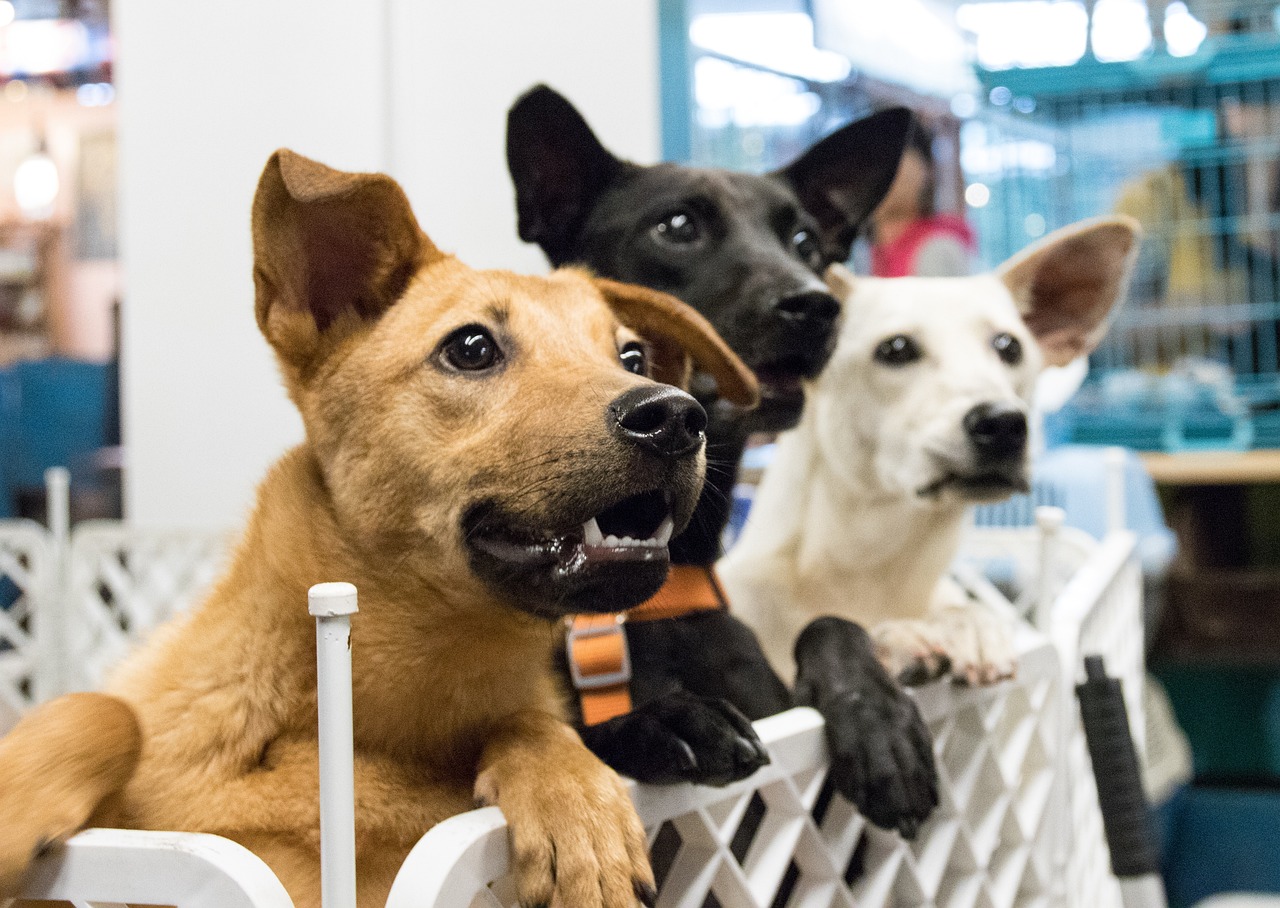
Effective Training Techniques
When it comes to training adopted pets, the journey can be as rewarding as it is challenging. Understanding effective training techniques is crucial for ensuring your furry friend not only learns but also enjoys the process. One of the most successful approaches involves establishing a training routine that incorporates positive reinforcement. This method encourages pets to repeat desired behaviors by rewarding them with treats, praise, or playtime. Imagine your pet as a student in a classroom; when they answer a question correctly, they receive a gold star. In this case, the gold star is a tasty treat or a loving scratch behind the ears!
Another vital aspect of effective training is consistency. Just like humans thrive on routine, pets benefit from having clear and predictable expectations. For instance, if you teach your dog to sit, it’s essential to use the same command and hand signal every time. This consistency helps your pet understand what you expect from them, making the learning process smoother and more enjoyable. Think of it this way: if you were learning a new language and the teacher changed the rules every day, you’d likely feel confused and frustrated. The same applies to our pets!
Moreover, incorporating a variety of training techniques can keep the sessions engaging. For instance, you might consider using clicker training, which involves using a small device that makes a clicking sound to mark the desired behavior. This sound acts as a bridge between the action and the reward, making it clear to your pet that they’ve done something right. It’s like giving them a high-five for their good behavior! Just remember, the goal is to make training a fun and positive experience, rather than a chore.
In addition to these methods, it’s essential to be patient and understanding. Every pet is unique, with their own pace of learning. Some may catch on quickly, while others might take a bit longer to grasp new commands. It’s important to celebrate small victories along the way. You might even consider keeping a training log to track progress and identify areas needing improvement. This can help you stay organized and motivated, ensuring that you and your pet are on the same page.
As you navigate through the training process, remember to keep sessions short and sweet. Pets, especially dogs, have short attention spans. A training session lasting 5 to 10 minutes can be far more effective than a lengthy hour-long ordeal. Think of it like a quick workout; a short, intense session can be more beneficial than dragging it out. This way, your pet remains engaged and excited about learning, rather than feeling overwhelmed.
In summary, effective training techniques for adopted pets revolve around positive reinforcement, consistency, patience, and fun. By embracing these strategies, you not only enhance your pet's behavior but also deepen the bond you share. After all, training is not just about commands; it’s about building a relationship based on trust and mutual respect.
- How long should training sessions last? - Ideally, keep training sessions between 5 to 10 minutes to maintain your pet's attention.
- What if my pet doesn’t respond to training? - Every pet learns at their own pace. Be patient, and consider revisiting the techniques or consulting a professional trainer.
- Is positive reinforcement really effective? - Yes! Positive reinforcement has been shown to create a positive learning environment that encourages pets to repeat desired behaviors.
- Can I train my adopted pet at home? - Absolutely! Many effective training techniques can be practiced at home, making it a convenient option for pet owners.
Positive Reinforcement Strategies
When it comes to training adopted pets, positive reinforcement stands out as one of the most effective and humane methods available. This approach is not just about rewarding your pet for good behavior; it's about creating a nurturing environment where your furry friend feels safe and valued. Imagine this: every time your pet does something you like, you shower them with praise, treats, or their favorite toy. This simple act of recognition can transform their behavior and deepen your bond.
Positive reinforcement works on the principle that behaviors followed by rewards are more likely to be repeated. For instance, if your dog sits on command and you reward them with a treat, they will associate sitting with something positive. Over time, this connection strengthens their desire to perform the desired behavior again. It's like giving your pet a little golden star for their good deeds!
To implement positive reinforcement effectively, consider the following strategies:
- Timing is Everything: Deliver the reward immediately after the desired behavior. This helps your pet make the connection between their action and the reward.
- Use High-Value Treats: Especially for challenging tasks or new commands, use treats that your pet loves. This could be anything from their favorite kibble to a small piece of chicken.
- Be Consistent: Consistency is crucial. Ensure that everyone in the household uses the same commands and rewards to avoid confusing your pet.
- Keep Training Sessions Short: Pets, especially younger ones, have short attention spans. Aim for training sessions that last no longer than 5-10 minutes to keep them engaged.
Additionally, it's important to remember that positive reinforcement isn't just about treats. Praise, playtime, and affection are also powerful rewards. For example, if your cat uses the litter box correctly, a gentle petting session can be just as effective as a treat. This variety keeps the training dynamic and enjoyable for both you and your pet.
Another aspect of positive reinforcement is the concept of shaping. This involves rewarding successive approximations of a desired behavior. For example, if you want your dog to roll over, start by rewarding them for lying down, then for rolling onto their side, and finally for completing the roll. This gradual approach not only makes learning easier for your pet but also builds their confidence.
In conclusion, positive reinforcement is a powerful tool in the training toolkit for adopted pets. Not only does it promote good behavior, but it also fosters a loving relationship between you and your pet. Remember, every time you reward your pet, you're not just teaching them; you're also building trust and creating a joyful environment where they can thrive.
- What is positive reinforcement? Positive reinforcement is a training method that involves rewarding desired behaviors to encourage their repetition.
- How long should training sessions last? Keep training sessions short, ideally between 5 to 10 minutes, to maintain your pet's attention and enthusiasm.
- Can I use other forms of rewards besides treats? Absolutely! Praise, playtime, and affection are also effective rewards that can motivate your pet.
- How can I ensure consistency in training? Make sure everyone in your household uses the same commands and rewards to avoid confusing your pet.
Consistency in Training
When it comes to training adopted pets, consistency is not just a nice-to-have; it’s a must-have. Imagine trying to learn a new language where the rules keep changing every day. Frustrating, right? Well, that’s exactly how your pet feels if the training methods and rules are inconsistent. Establishing a consistent training routine helps your furry friend understand what is expected of them, making the learning process smoother and more effective.
One of the best ways to ensure consistency is to create a structured training schedule. This doesn’t mean you have to stick to a rigid timetable, but having regular training sessions can significantly enhance your pet’s ability to learn. For instance, you might decide to train your pet for 10-15 minutes each day at the same time. This predictability provides your pet with a sense of security, allowing them to focus on learning rather than worrying about what’s coming next.
Another critical aspect of consistency is the use of the same commands and cues. If you call “come” one day and “get over here” the next, your pet is likely to be confused. Stick to a set of commands and use them uniformly. For example, if you decide to use “sit” as your command, make sure everyone in the household uses the same word. This uniformity helps your pet associate the command with the action, reinforcing their learning.
Moreover, it’s essential to maintain consistent consequences for behaviors. If your pet jumps on the couch and you allow it one day but scold them the next, they’ll be left scratching their head (or pawing at the couch) in confusion. Make sure that the rules are clear and that everyone in the household is on the same page regarding what behaviors are acceptable and which are not. This not only helps in training but also fosters a sense of trust between you and your pet.
Incorporating rewards into your training routine is another way to maintain consistency. Whether you use treats, praise, or playtime as a reward, be sure to apply the same form of reinforcement each time your pet successfully follows a command. This helps them understand that their good behavior leads to positive outcomes, making them more likely to repeat those actions in the future.
To summarize, here are some key points to remember for achieving consistency in training:
- Establish a regular training schedule.
- Use the same commands and cues consistently.
- Maintain uniform consequences for behaviors.
- Incorporate consistent rewards for good behavior.
By committing to these principles of consistency, you not only enhance your pet's learning experience but also build a stronger, more trusting relationship. Remember, training is a journey, and with consistency as your guiding star, you’ll navigate it successfully!
Q: How long should training sessions be?
A: Training sessions should ideally last between 10-15 minutes, depending on your pet's attention span. Short, frequent sessions are usually more effective than longer, infrequent ones.
Q: What if my pet doesn’t respond to commands?
A: If your pet isn’t responding, it may be a sign that the training methods need adjustment. Ensure you’re using consistent commands and rewards, and consider consulting a professional trainer for additional guidance.
Q: Can I train my adopted pet at any age?
A: Absolutely! While younger pets may learn faster, older pets can still learn new behaviors. It’s never too late to start training and building a better bond with your pet.
Frequently Asked Questions
- Why is training important for adopted pets?
Training is vital for adopted pets as it helps them adjust to their new environment, reduces behavioral issues, and strengthens the bond between the pet and their owner. It provides structure and predictability, which are essential for their well-being.
- What specific needs do adopted pets have?
Adopted pets often come from varied backgrounds and may have unique experiences that affect their behavior. Understanding their individual needs, such as anxiety or past trauma, is crucial for tailoring a training approach that fosters trust and security.
- How can training improve my adopted pet's behavior?
Training can significantly enhance your pet's behavior by addressing issues like anxiety or aggression. By using consistent techniques, you can teach your pet how to respond appropriately to different situations, leading to a more harmonious home environment.
- What methods are effective for reducing anxiety in newly adopted pets?
Implementing training routines that provide structure can help alleviate anxiety in newly adopted pets. Techniques such as positive reinforcement and gradual exposure to new experiences can create a sense of safety and predictability for your pet.
- How can I prevent aggressive behaviors in my adopted pet?
To prevent aggressive behaviors, it's essential to train your pet in a calm and consistent manner. Teaching them appropriate responses to various situations and rewarding positive behavior can help them feel more secure and reduce fear-based aggression.
- What are some positive reinforcement strategies I can use?
Positive reinforcement strategies include rewarding your pet with treats, praise, or playtime when they exhibit desired behaviors. This approach encourages them to repeat those actions, creating a fun and effective learning environment.
- How important is consistency in training?
Consistency is crucial in training because it helps your pet understand what is expected of them. Establishing clear rules and routines makes the training process smoother and more effective, leading to better outcomes for both you and your pet.






